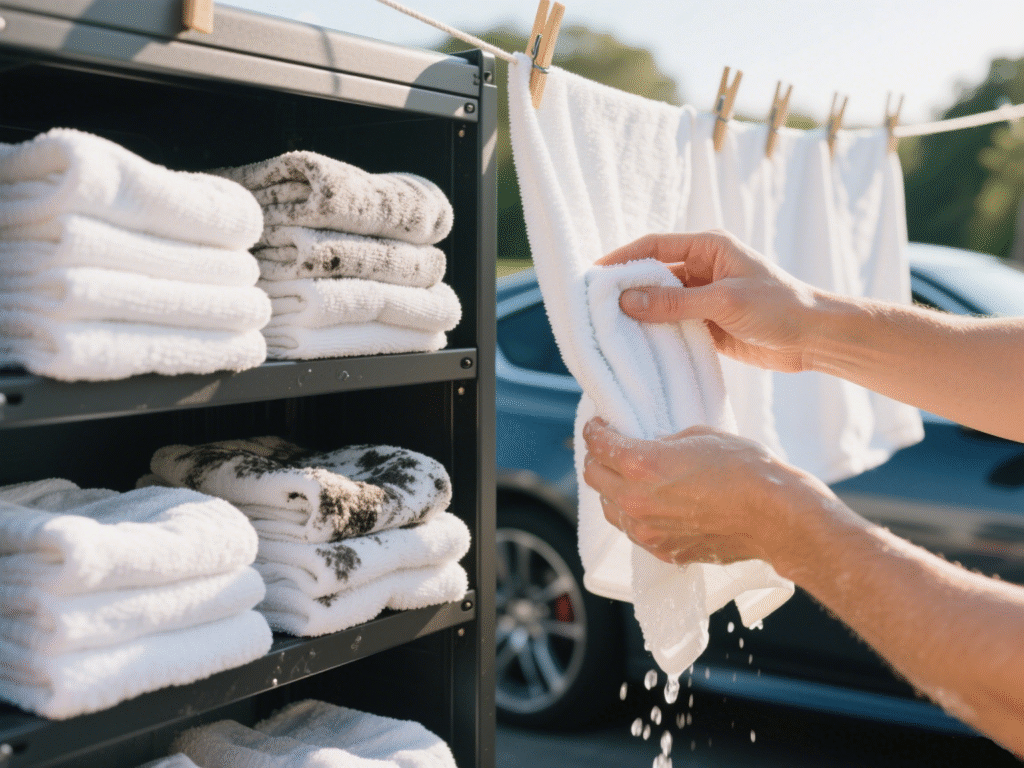
How to Wash Car Towels is one of the most important skills for anyone serious about car care. If you value your car’s appearance, chances are you’ve invested in high-quality microfiber towels. These little squares of magic are the unsung heroes of detailing—delivering streak-free windows, scratch-free paint correction, and waterless washes that protect your clear coat.
But here’s the catch: if you don’t know how to wash car towels properly, they’ll stop working long before they should. In fact, the average microfiber towel can last for 500+ washes if treated correctly—but only 5 washes if treated like a regular bath towel.
So why does washing matter so much? Let’s break it down.
Protect Your Car’s Paint
Paint isn’t as tough as it looks. Even with ceramic coatings or wax protection, the clear coat can be scratched by microscopic contaminants. When towels aren’t washed properly, they harbor:
- Dirt and grit particles.
- Brake dust containing sharp iron fragments.
- Hardened wax and sealant residues.
Every time you reuse a dirty towel, you’re basically rubbing sandpaper on your car. Proper washing = swirl-free paint.
Keep Towels Absorbent
Microfiber’s biggest superpower is absorbency. A well-maintained towel can hold 7x its weight in water. That means fewer passes, faster drying, and better detailing results.
But once fibers get clogged with soap, wax, or fabric softener, towels lose their thirsty nature. Instead of absorbing, they push water around like a cheap T-shirt.
Save Money Long-Term
A professional-grade towel costs anywhere from $5 to $20 depending on GSM and weave. Replacing 20–30 towels prematurely because of poor washing habits can easily cost a few hundred dollars per year.
Proper towel care is basically free money—it keeps towels performing like new while avoiding unnecessary repurchases.
💡 Humor: “Because nobody wants their $20 microfiber to turn into a $2 dish rag.”
The Golden Rules of How to Wash Car Towels
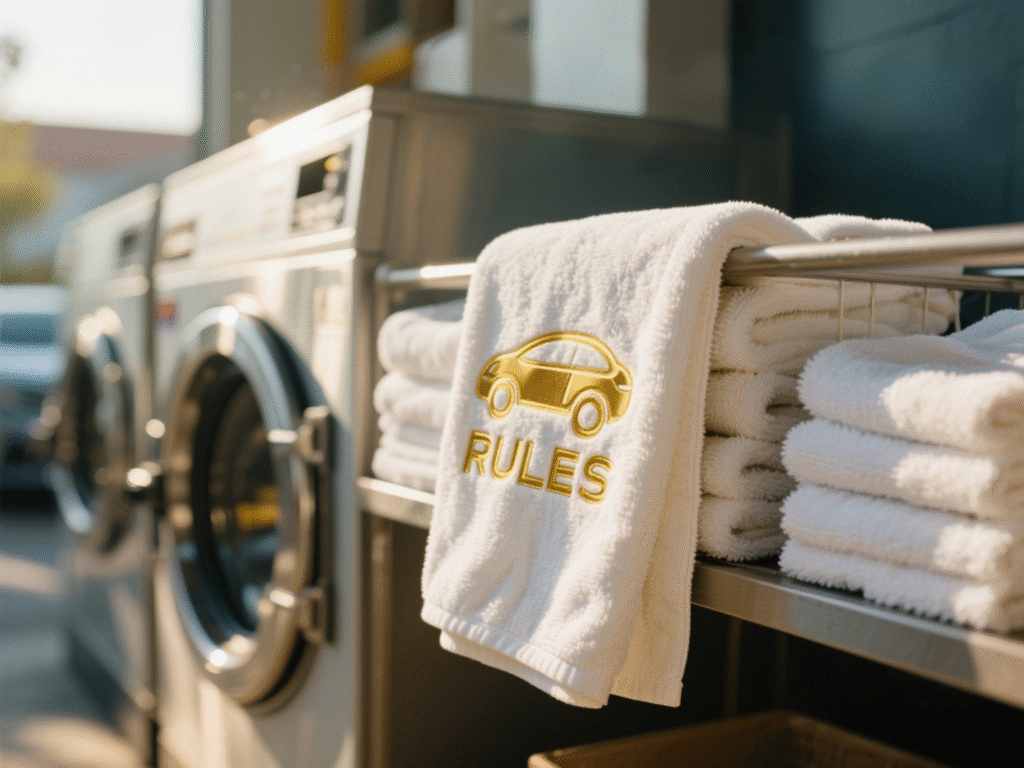
Now that you know the why, let’s tackle the how.
There are some universal rules that every professional detailer (and towel manufacturer) agrees on. Break them, and your towels won’t last. Follow them, and your towels will outlive your car.
Sorting Towels Before Washing
Think of sorting as “towel triage.” Just as you wouldn’t mix greasy shop rags with your bedsheets, you shouldn’t wash wheel towels with paint towels.
Why Sorting Matters
- Paint towels must stay ultra-clean—any contamination can scratch.
- Wheel towels touch brake dust and iron—absolute paint killers.
- Glass towels need lint-free performance—one fiber of dirt and streaks appear.
- Interior towels often soak up dressings and chemicals that don’t belong on paint.
Mixing them = cross-contamination.
⚡ Example: Brake dust from wheel towels transferring to a drying towel → next time you wipe the hood, you’re dragging iron filings across your clear coat.
Pro Tip: Color-Code Your Towels
Buy towels in bulk in different colors:
- Yellow = paint.
- Blue = glass.
- Black = wheels.
- Gray = interior.
Color-coding = fewer mistakes, faster workflow, safer detailing.
Related Tip: Choosing the Best Towel for Drying Your Car
Once your towels are clean, the next big question is: how do you dry your car without scratching it? The right drying towel can make all the difference between a flawless finish and unwanted swirls. If you want to take your detailing game to the next level, check out our in-depth guide on “what’s the best towel to dry car”—it dives into towel types, GSM comparisons, and expert recommendations to keep your paint perfect.
Choosing the Best Detergent for Car Towels
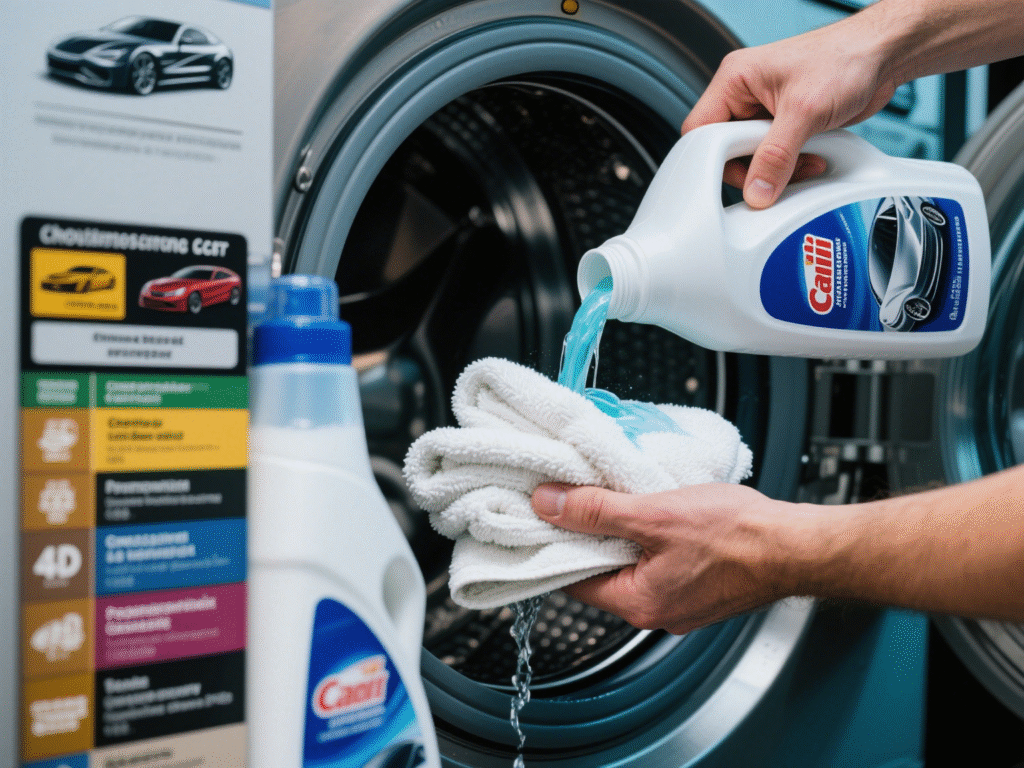
Choosing detergent is just as important as sorting. Wrong detergent = clogged fibers.
Detergents to Avoid
Fabric softener: Leaves a waxy coating that ruins absorbency.
Bleach: Breaks down the split microfiber structure.
Powder detergents: Can leave residue clumps in fibers that scratch paint.
Best Detergents for Microfiber Towels
- Dedicated microfiber detergents: Designed to unclog fibers and remove wax, sealants, and dirt. (Examples: P&S Rags to Riches, Adam’s Microfiber Revitalizer.)
- Mild liquid detergents: Unscented, dye-free, enzyme-free formulas are safe alternatives.
📊 Data point: Proper detergents can restore up to 90% of lost absorbency in clogged microfiber.
Washing Car Towels: Machine Wash vs. Hand Wash
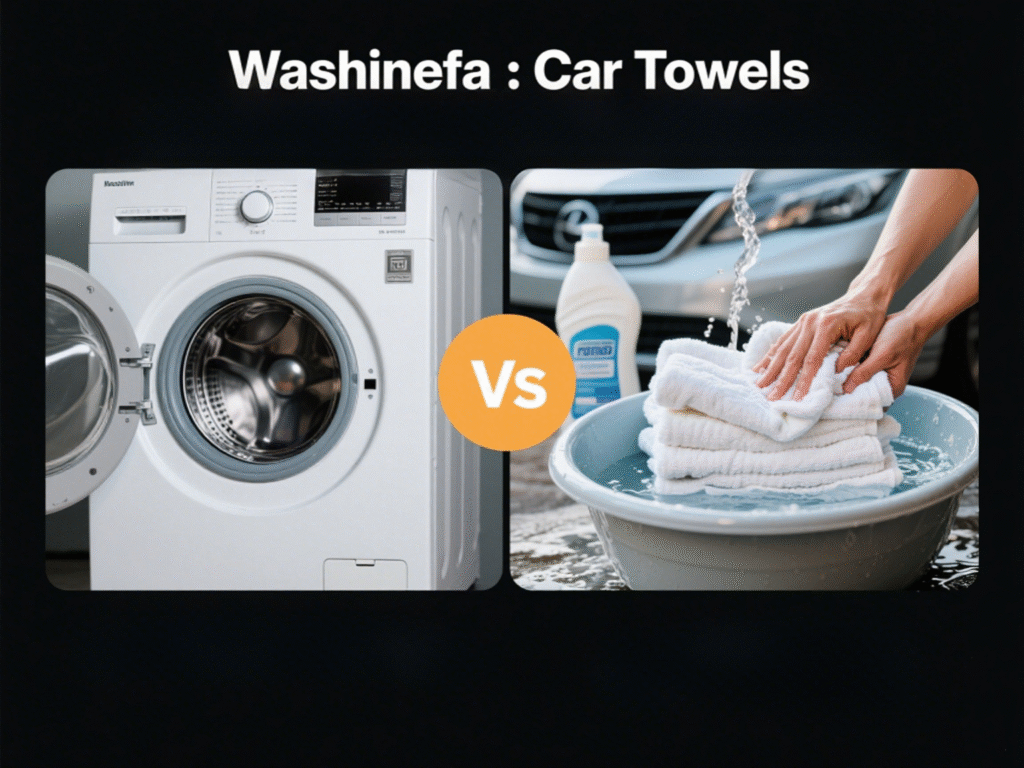
Both methods work—but each has its place.
Machine Wash Method
- Use cold or warm water (never hot).
- Select gentle cycle with extra rinse.
- Avoid overloading the machine (towels need room to agitate).
Hand Wash Method
Best for small batches or heavily soiled towels.
- Fill a bucket with warm water + microfiber detergent.
- Agitate towels manually.
- Rinse thoroughly until water runs clear.
⚠️ Warning: Never wash towels with clothes. Cotton lint + microfiber = nightmare.
How to Dry Car Towels Without Damaging Them
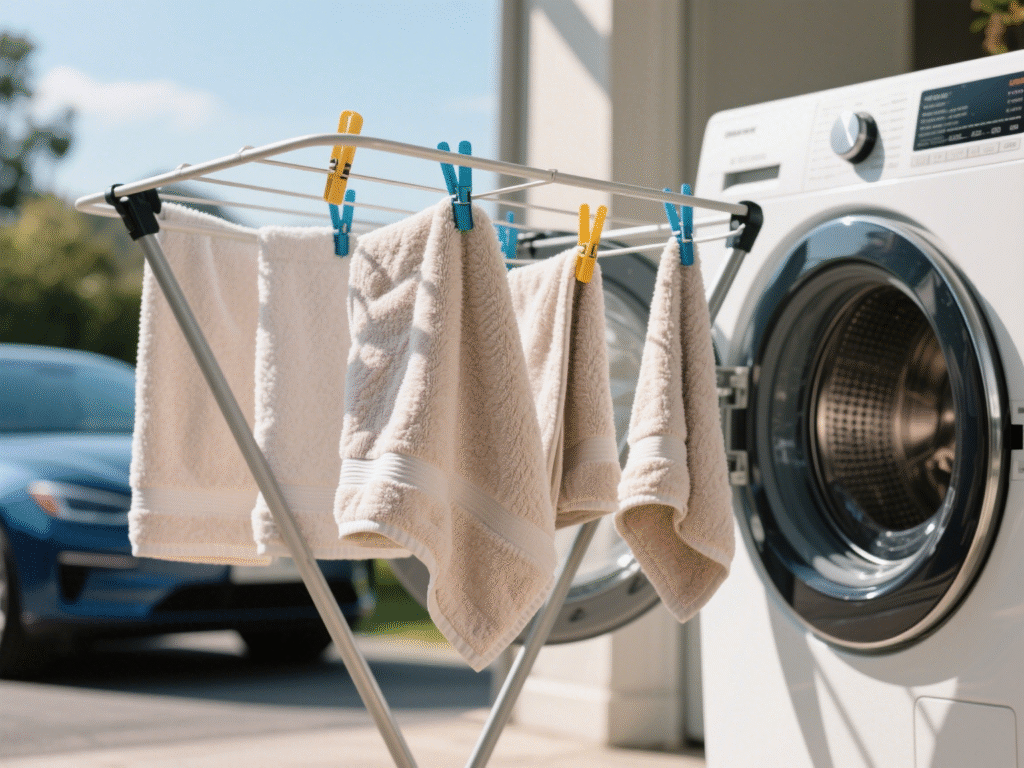
Drying is where many people ruin perfectly good towels.
Air Dry vs. Machine Drying Microfiber Towels
Air Drying
- Hang indoors on a clean rack.
- Avoid outdoor drying where wind blows dust/pollen onto fibers.
Machine Drying
- Tumble dry on low heat or air-fluff mode.
- Remove promptly to prevent wrinkles or static.
💡 Humor: “High heat is like a tanning bed for your towels—burnt and wrinkled.”
Common Drying Mistakes to Avoid
Drying towels seems simple, but the wrong approach can undo all the effort you put into proper washing.
- Never iron microfiber: Heat flattens and melts fibers.
- Skip dryer sheets: They coat fibers in chemicals and ruin absorbency.
Using High Heat in the Dryer
Microfiber is a blend of polyester and polyamide—synthetic plastics that melt under high heat. Using the “cotton” or “high heat” setting on your dryer can permanently damage fibers, leaving towels stiff and useless. Always stick to low heat or air-dry.
Adding Dryer Sheets or Fabric Softener
Dryer sheets release silicone-based chemicals that coat fibers. While this might make bath towels feel soft, it clogs microfiber’s pores, destroying absorbency and cleaning power.
Letting Towels Sit Damp
Leaving freshly washed towels in the dryer or laundry basket while damp invites mildew and bad odors. Worse, mold growth can damage fibers permanently. Always dry towels fully before storing.
Ironing Microfiber Towels
It may sound obvious, but some people try to iron microfiber for a “flat finish.” The result? Melted, shiny patches that no longer absorb water. Microfiber and irons do not mix.
Pro Tips to Keep Your Car Towels in Top Condition
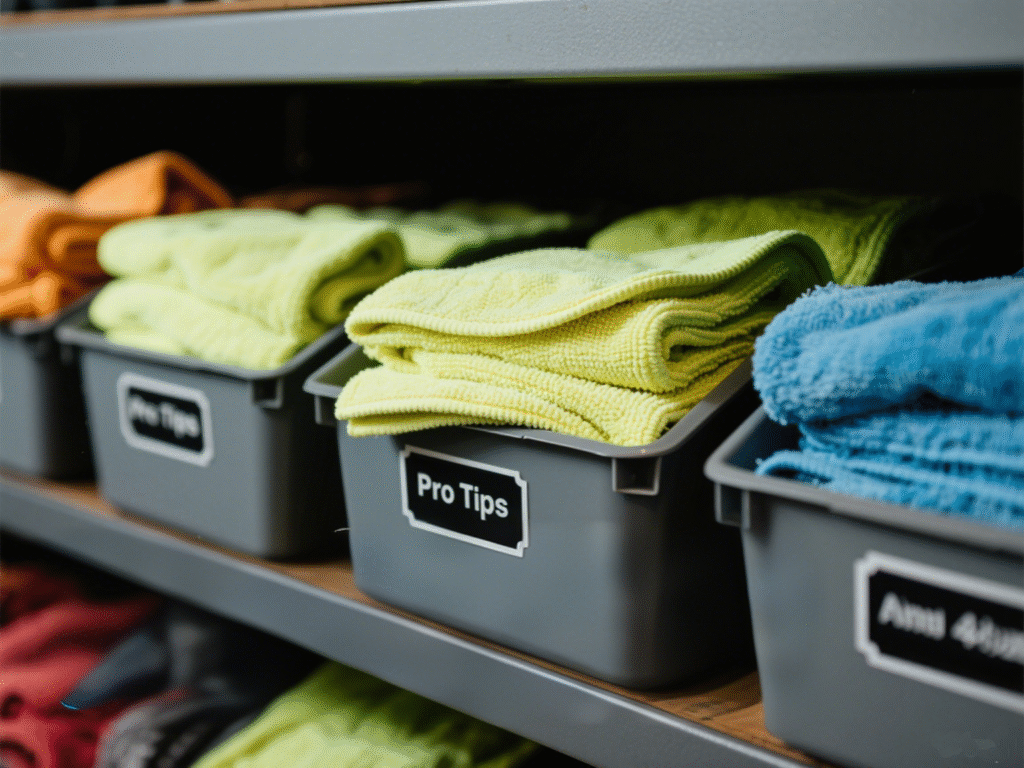
Proper washing and drying are only half the story. Long-term towel care ensures you get maximum value from every microfiber.
- Wash new towels before first use: Removes factory residues.
- Stick to your color-coding system.
- Store in airtight bins/bags: Keeps towels dust-free.
- Rotate usage: Retire old towels for dirtier jobs (engine bay, wheels).
Pre-Wash New Towels
Brand-new towels often carry manufacturing oils, lint, and residues. Always wash them before first use to maximize softness and absorbency.
Stick to a Color-Coding System
Assign colors for paint, glass, wheels, and interiors. This prevents cross-contamination and makes towel organization effortless.
Use Dedicated Storage Containers
Keep towels in airtight plastic bins or sealable bags. This prevents dust, pet hair, and garage debris from contaminating fibers.
Retire Old Towels for Secondary Tasks
Even the best microfiber has a lifespan. Instead of tossing old towels, demote them to dirty jobs like engine bays, exhaust cleaning, or household chores.
Rotate Towels in Your Collection
If you own 20 towels, don’t always grab the same few. Rotate your stock so all towels wear evenly. This extends the life of the entire collection.
Eco-Friendly & Cost-Saving Ways to Wash Car Towels
Caring for your towels doesn’t have to come at the expense of the planet—or your wallet. Small changes in how you wash can save energy, water, and money.
- Wash in cold water to save energy.
- Use eco-friendly detergents designed for microfiber.
- Repurpose old towels for household cleaning.
- Some detailing shops now offer towel recycling programs.
Wash with Cold Water When Possible
Modern detergents clean effectively even in cold water. Switching from hot to cold reduces energy consumption by up to 90%.
Choose Eco-Friendly Detergents
Plant-based, biodegradable detergents that are free from dyes and fragrances not only protect the environment but are also safer for microfiber fibers.
Repurpose Old Towels Instead of Throwing Them Away
When towels lose absorbency, don’t toss them. Use them for garage cleanup, applying tire dressings, or even as household rags. This extends their utility and reduces waste.
Wash in Full Loads (But Don’t Overstuff)
Washing towels in full—but not overloaded—loads saves water and energy. Plus, the extra space allows towels to agitate properly, improving cleaning efficiency.
Support Towel Recycling Programs
Some professional detailing shops and eco-friendly companies now accept old microfiber towels for recycling. Check if local detailing suppliers offer these programs.
Common Myths About Washing Car Towels (Debunked)
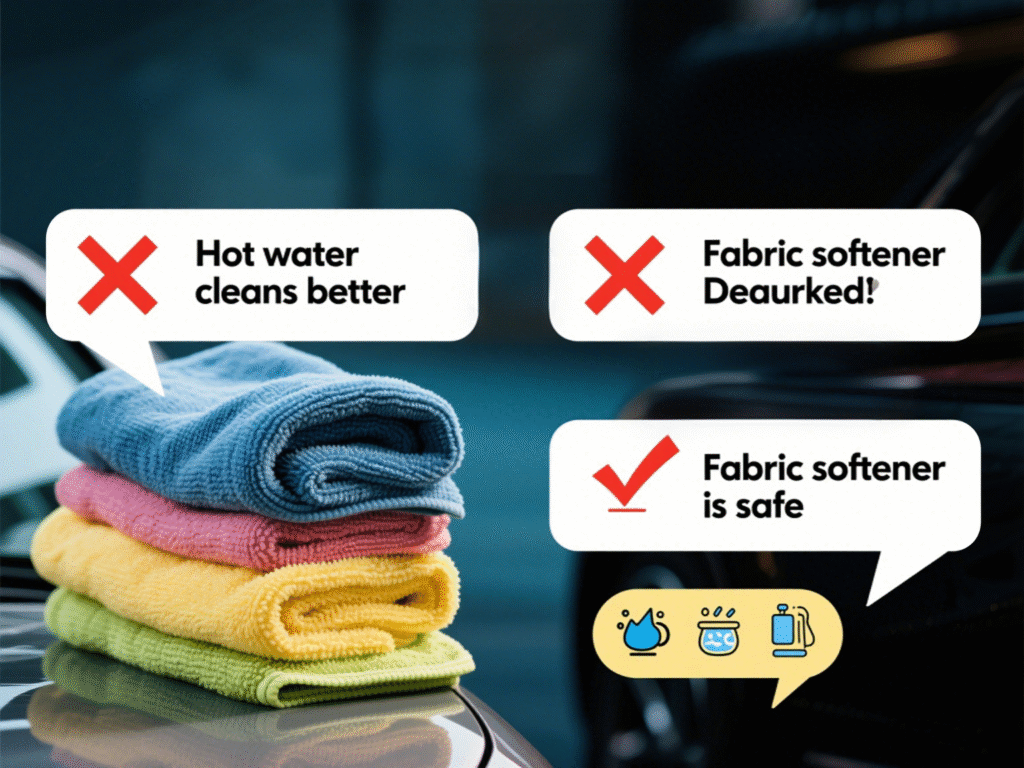
The internet is full of half-truths about microfiber care. Let’s bust the biggest myths with real science.
Myth #1: Fabric Softener Makes Towels Softer
Truth: Fabric softener coats fibers, eliminating their ability to absorb water and grab dirt. Towels may feel silky, but they won’t perform.
Myth #2: Hot Water Cleans Better
Truth: Microfiber fibers are heat-sensitive. Water above 140°F (60°C) can melt and deform them. Warm water is enough to clean without damage.
Myth #3: All Towels Are the Same
Truth: Towels differ in GSM (thickness) and weave (plush, waffle, suede). A drying towel with 1000 GSM is not interchangeable with a 250 GSM glass towel. Using the wrong towel leads to poor results and unnecessary wear.
Myth #4 – Microfiber Lasts Forever
Truth: Even with perfect care, microfiber wears down after 500–600 washes. Fibers eventually lose their split edges and become less effective. Proper washing only delays the inevitable.
Myth #5 – You Can Wash Towels with Vinegar Alone
Truth: Vinegar is useful as a rinse aid (to dissolve residues), but it does not replace detergent. A combination of microfiber-safe detergent + vinegar rinse is most effective.
Frequently Asked Questions About How to Wash Car Towels
Yes—your washing machine is your microfiber’s best friend. Just make sure you don’t invite its worst enemies: fabric softener, bleach, or high heat. Those will ruin absorbency faster than a donut disappears in a detailer’s break room.
Absolutely. In fact, they should be washed. A dirty drying towel is basically sandpaper in disguise, and your car’s paint deserves better than that.
Yes—treat them like VIPs. Wash them separately from cotton and lint-producing fabrics, use liquid detergent (not powder), skip the fabric softener, and dry on low heat. Think of it like a spa day for your towels.
A mild, liquid detergent without fragrances, dyes, or softeners works best. If you really want to go fancy, there are “microfiber-safe” detergents, but your regular gentle laundry soap will usually do the job. Just don’t grab that bargain-bin lavender-scented softener mix—it’ll clog the fibers.
Warm water is the sweet spot. Cold doesn’t break down grime well, and hot can damage the fibers. About 40°C / 104°F is perfect—warm enough to clean, gentle enough to protect.
Same rules as any microfiber: separate by use (paint vs. wheels), wash with liquid detergent, no fabric softener, and dry on low. Auto Drive didn’t invent magic towels—care for them like the rest.
After every use. A towel that’s touched your car’s paint, wheels, or glass shouldn’t go back in the drawer dirty. Reusing them without washing is like reusing socks—you can, but nobody’s impressed.
For extra grimy towels, soak them in a bucket of warm water with a splash of distilled white vinegar before washing. Then run them through the machine on warm with detergent. If they’re still greasy, repeat until they’re fluffy again. Basically, microfiber rehab.



